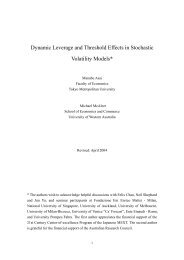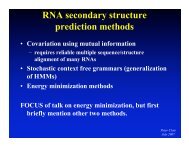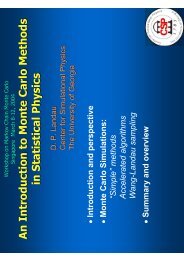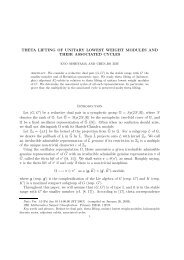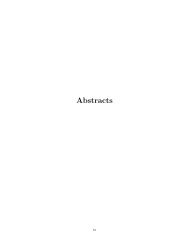Stein's method, Malliavin calculus and infinite-dimensional Gaussian
Stein's method, Malliavin calculus and infinite-dimensional Gaussian
Stein's method, Malliavin calculus and infinite-dimensional Gaussian
Create successful ePaper yourself
Turn your PDF publications into a flip-book with our unique Google optimized e-Paper software.
On the other h<strong>and</strong>, by noting h A 1(x) = h(A 1 x), one obtains by st<strong>and</strong>ard computations (recall<br />
that A is symmetric) that Hess U 0 g(x) = Hess h A 1(x) = A 1 Hess h(A 1 x)A 1 ; yielding<br />
sup kHess U 0 g(x)k H:S: = sup kA 1 Hess h(A 1 x)A 1 k H:S:<br />
x2R d x2R d<br />
= sup<br />
x2R d kA 1 Hess h(x)A 1 k H:S:<br />
<br />
kA 1 k 2 op sup<br />
x2R d kHess h(x)k H:S: (8.23)<br />
kA 1 k 2 op kAk op kgk L (8.24)<br />
kC 1 k op kCk 1=2<br />
op kgk L : (8.25)<br />
The chain of inequalities appearing in formulae (8.23)–(8.25) are mainly a consequence of the<br />
usual properties of the Hilbert-Schmidt <strong>and</strong> operator norms. Indeed, to prove inequality (8.23)<br />
we used the relations<br />
kA 1 Hess h(x)A 1 k H:S: kA 1 k op kHess h(x)A 1 k H:S:<br />
kA 1 k op kHess h(x)k H:S: kA 1 k op ;<br />
relation (8.24) is a consequence of (8.22); …nally, to show the inequality (8.25), one uses the fact<br />
that<br />
q<br />
q<br />
q q<br />
kA 1 k op kA 1 A 1 k op = kC 1 k op <strong>and</strong> kAk op kAAk op = kCk op :<br />
We are now left with the proof of Point (i) in the statement. The fact that a vector Y N d (0; C)<br />
necessarily veri…es (8.19) can be proved by st<strong>and</strong>ard integration by parts. On the other h<strong>and</strong>,<br />
suppose that Y veri…es (8.19). Then, according to Point (ii), for every g 2 C 2 (R d ) with bounded<br />
…rst <strong>and</strong> second derivatives,<br />
E(g(Y )) E(g(Z)) = R(hY; rU 0 g(Y )i R d hC; Hess U 0 g(Y )i H:S: ) = 0;<br />
where Z N d (0; C). Since the collection of all such functions g generates the Borel -…eld on<br />
R d , this implies that Y Law = Z, thus yielding the desired conclusion.<br />
9 Explicit bounds using <strong>Malliavin</strong> operators<br />
9.1 One-<strong>dimensional</strong> normal approximation<br />
Consider a st<strong>and</strong>ard <strong>Gaussian</strong> r<strong>and</strong>om variable N N (0; 1), as well as a functional F of some<br />
isonormal <strong>Gaussian</strong> process X = fX (h) : h 2 Hg. We are interested in assessing the distance<br />
between the law of N <strong>and</strong> the law of F by using relations (8.6)–(8.8). As shown in the next<br />
statement, which has been …rst proved in [57], this task is particularly easy if one assumes that<br />
F is also <strong>Malliavin</strong> di¤erentiable.<br />
Theorem 9.1 (See [57]) Let F 2 D 1;2 be such that E [F ] = 0. Then, one has that<br />
<br />
d W (F; N) E 1 DF; DL 1 F H<br />
(9.1)<br />
<br />
E[(1 DF; DL 1 F H )2 ] 1=2<br />
43








